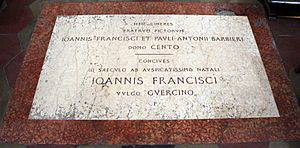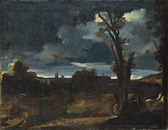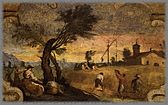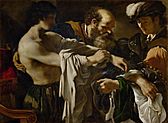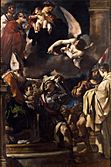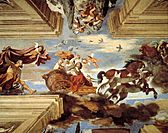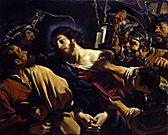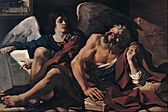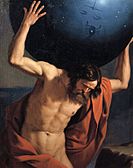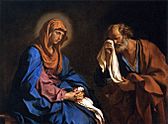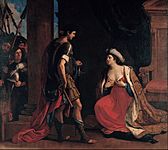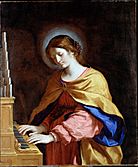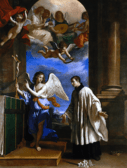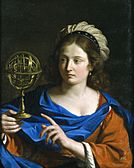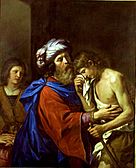Guercino facts for kids
Quick facts for kids
Guercino
|
|
|---|---|

Self portrait, c. 1635
|
|
| Born |
Giovanni Francesco Barbieri
February 8, 1591 Cento, Duchy of Ferrara
|
| Died | December 22, 1666 (aged 75) |
| Nationality | Italian |
| Known for | Painting, drawing |
| Movement | Baroque |
Giovanni Francesco Barbieri (born February 8, 1591 – died December 22, 1666), was a famous Italian painter and draftsman. He is better known by his nickname, Guercino.
Guercino was a key artist of the Baroque period. He came from Cento, a town in the Emilia region of Italy. He worked in important cities like Rome and Bologna. His early paintings were very realistic and full of energy. Later, his style became more balanced and classical. His many drawings are admired for their bright, lively look.
Contents
Guercino's Early Life and Art
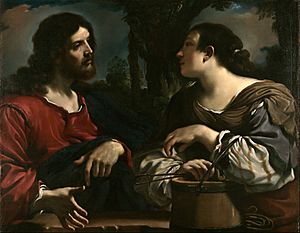
Giovanni Francesco Barbieri was born into a family of farmers in Cento. This town is located between Bologna and Ferrara. Because he was cross-eyed, people gave him the nickname Guercino. This name means 'squinter' in Italian.
Guercino mostly taught himself how to paint. When he was 16, he became an apprentice to Benedetto Gennari. Gennari was a painter from the Bolognese School. One of Guercino's first big jobs was painting frescos in Casa Pannini in Cento (1615–1616). His landscapes in these frescos already showed his unique style. Paintings like Moonlit Landscape and Country Concert from the same time also prove this.
In Bologna, he earned praise from the artist Ludovico Carracci. Guercino always said that his early style was inspired by Carracci's painting of the Madonna.
Famous Early Works
Around 1618–1622, Guercino painted Et in Arcadia ego. This painting was the first to use this Latin phrase. It means that "death is present even in the most beautiful places." This dramatic painting was made for the Grand Duke of Tuscany. It shows the strong, energetic style typical of Guercino's early art.
He also painted two large canvases for Cardinal Serra: Samson Seized by Philistines (1619) and Elijah Fed by Ravens (1620). These works show a very realistic style, similar to the artist Caravaggio. It's thought that Guercino had not yet seen Caravaggio's work in Rome when he painted these.
Time in Rome
In 1621, Guercino was invited to Rome by Pope Gregory XV. The Pope was from Bologna, Guercino's home region. Guercino spent two very busy years in Rome, from 1621 to 1623.
During this time, he created many important works. These include the beautiful Aurora frescos at the Villa Ludovisi. He also painted the ceiling of San Crisogono, showing San Chrysogonus in Glory. He painted a portrait of Pope Gregory XV, which is now in the Getty Museum. One of his most famous works from this period is the St. Petronilla Altarpiece. This large painting was made for St. Peter's Basilica in the Vatican.
Return to Bologna and Later Career
After Pope Gregory XV died in 1623, Guercino went back to his hometown of Cento. In 1626, he started painting frescos in the Duomo of Piacenza.
We know a lot about his career after 1629 from a special account book. This book, called the Libro dei Conti di Casa Barbieri, was kept by Guercino and his brother Paolo Antonio Barbieri. Paolo was a painter of still life scenes. This book helps us understand Guercino's work and earnings.
In 1642, a major event happened: the death of Guido Reni. Reni was a very famous painter in Bologna and Guercino's main rival. After Reni's death, Guercino moved his busy art workshop to Bologna. He then became the city's most important painter of religious art.
Some of Guercino's later paintings look more like Reni's style. They use much more light and are clearer than his earlier works. His early paintings often used strong contrasts of light and shadow, called chiaroscuro. In 1655, he painted a large altarpiece for the Franciscan Order. He continued to paint and teach until the end of his life.
Guercino's Art and Students
Guercino was known for how quickly he could finish his paintings. He completed over 100 large altarpieces for churches. He also made about 144 other paintings. He was also a very active draftsman, meaning he made many drawings.
His drawings were usually done with ink, washed ink, or red chalk. Many were studies for his paintings. But he also drew landscapes, everyday scenes, and even funny caricatures just for fun. Guercino's drawings are famous for their smooth, flowing style. He used quick, artistic pen strokes combined with dots and lines to create shapes.
Guercino kept painting and teaching until he died on December 22, 1666, in Bologna. He became quite wealthy during his lifetime. Since he never married, his money and property went to his nephews and students, Benedetto Gennari II and Cesare Gennari. Many other artists also learned from him.
Works
Exhibitions and Legacy
Many exhibitions have shown Guercino's art to the public. A very important show happened in Bologna in 1968. It displayed many of his works, including those from his later career. These later works had not received much attention before.
In 1991, for the 400th anniversary of his birth, a larger exhibition was held. It traveled to Bologna, Frankfurt, and Washington. These shows were put together by Denis Mahon, a big supporter of Guercino's art. More recently, exhibitions have been held in Rome (2011–2012) and Warsaw (2013–2014). These events continue to celebrate Guercino's amazing talent.
See also
 In Spanish: Guercino para niños
In Spanish: Guercino para niños




